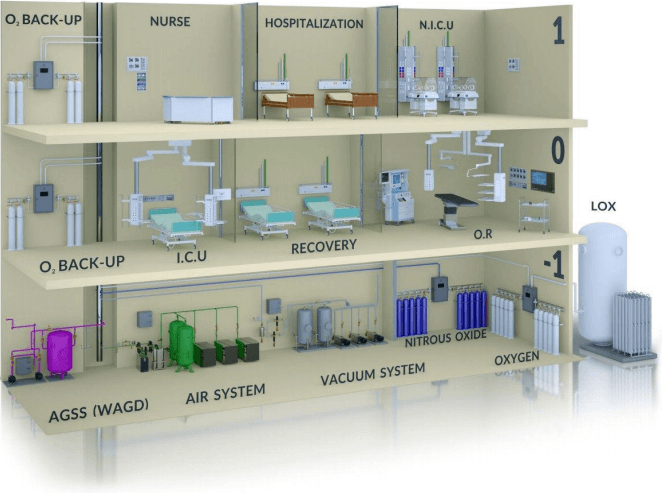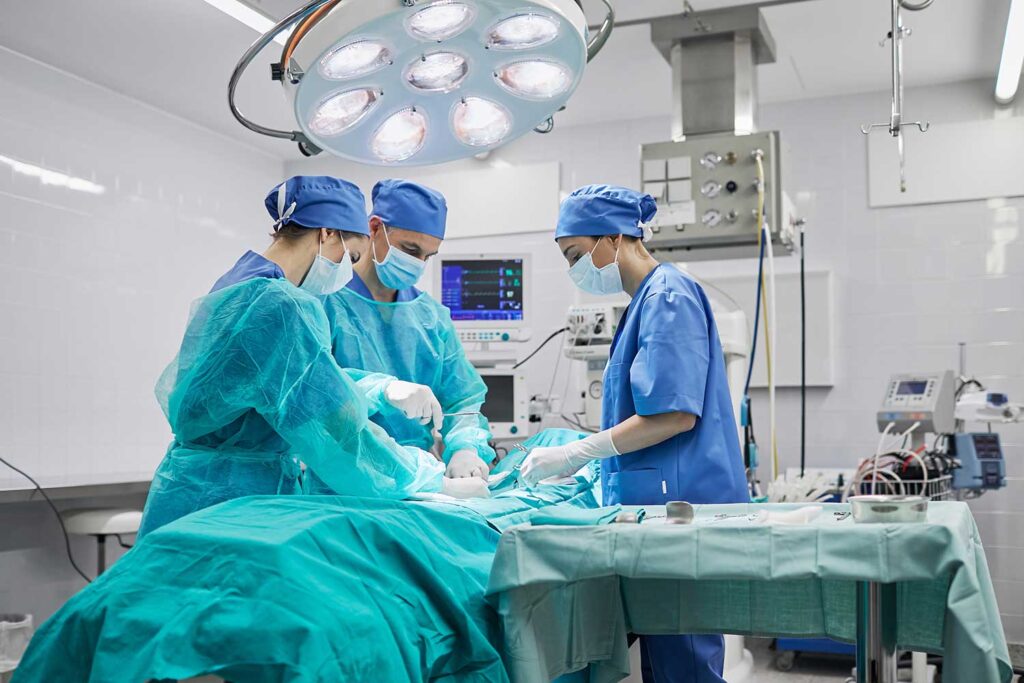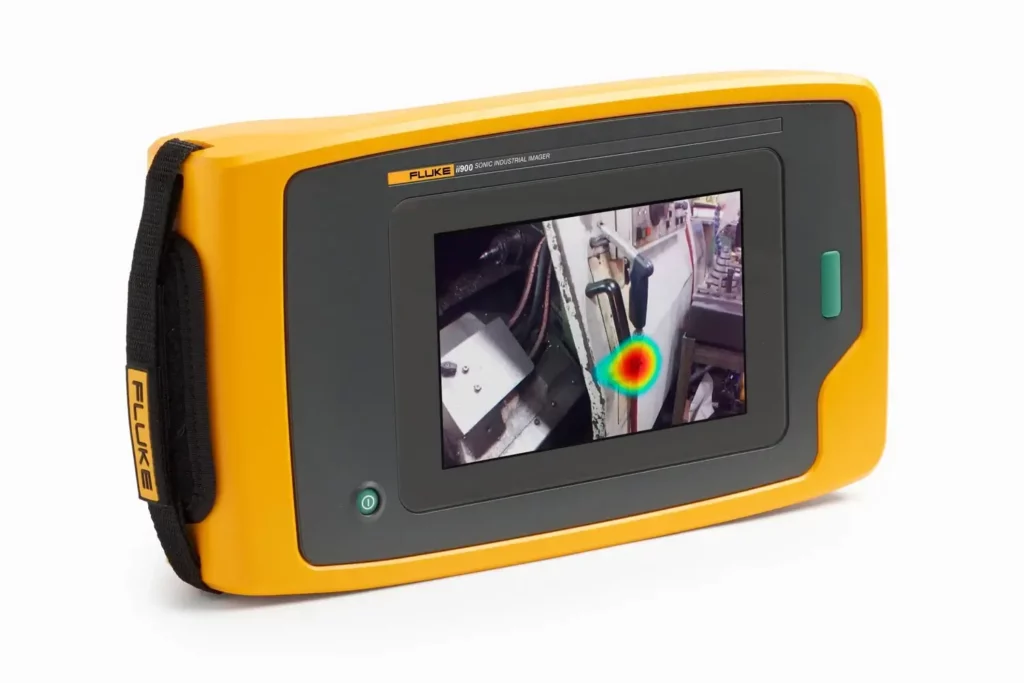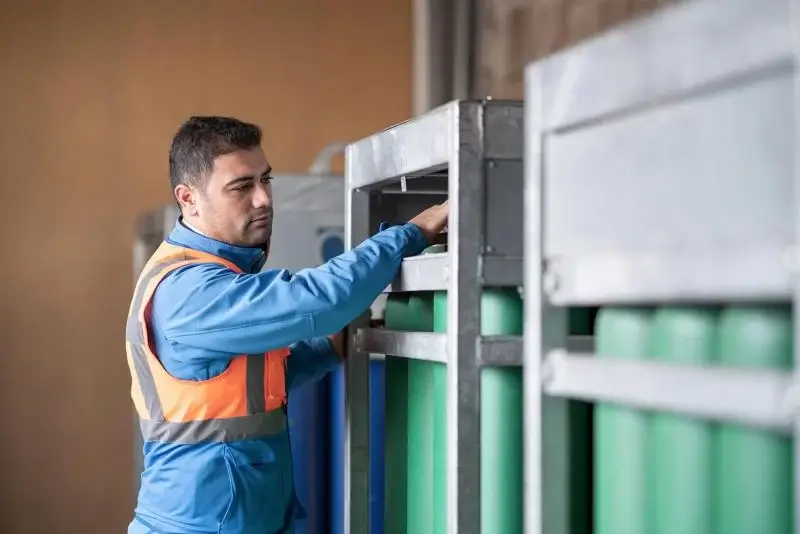Medical gas leaks in healthcare facilities create serious challenges for maintenance teams. Before you can start detecting leaks in compressed medical gas lines, you need to understand:
- Medical gases, uses, and restrictions
- Risks associated with medical gases
- Leak detection restrictions and options
1. Medical gases, uses, and restrictions
Besides healing patients, healthcare facilities are constantly trying to mitigate risk. There are hundreds of variables they need to closely monitor regarding equipment, treatments, supplies, and environmental conditions to protect the patients in their care and protect their employees and visitors.

One of the most critical supplies they must manage and maintain is compressed medical gas. Medical gases are regulated by the US Food and Drug Administration (FDA) as pharmaceuticals, which means they require a prescription for use. They are one the most frequently administered drugs in the United States and must be transported, stored, and dispensed under strict standards, which extend to delivery components such as tanks, regulators, and tubing.
The most common medical gases certified for use in medical care, include:
- Oxygen: Used for patients who don’t have enough oxygen in their blood due to illness or injury. In large medical facilities, oxygen is typically stored as a liquid in large bulk containers offsite. The liquid is evaporated into a concentrated oxygen supply that is piped throughout the facility through pipes. Smaller medical facilities often store oxygen in large tanks in the medical gas storage room and pipe it from there throughout the hospital.
- Nitrogen: Commonly used to power surgical equipment, to freeze and preserve blood, tissue, and other biological specimens, or to destroy diseased tissue in dermatological or cryosurgery applications.
- Nitrous oxide: Used to relieve pain, especially for dental and preoperative procedures. Also used for Anesthetic procedures. Medical grade IP 2010 Certified safe for human use. – Purity 99-100% in liquefied form
- Carbon dioxide: Used in laser and laparoscopic surgery and is also combined with oxygen to treat respiratory disorders.
- Helium: Used to treat upper airway obstructions or increased airway resistance to help patients breathe more easily. It is also used in liquefied form to help MRI machines produce high-resolution images without exposing the patient to radiation.
- Medical air: Used primarily in intensive care units (ICU) and with pulmonary nebulizers, Cpap, Bipap, Ventillator, etc. To reduce the risk of excess oxygen in the lungs and other body tissue while a patient is on a ventilator or during surgical procedures. It is produced by a specialized air compressor that pressurizes clean outside air and supplies it to patient care areas.
- Carbon monoxide: Used in very small amounts in lung diffusion testing to help determine how well a patient’s lungs are exchanging gases.
Many of these individual gases may also be mixed for other patient diagnostics, to calibrate and maintain medical devices, or in the lab to control the growth of biological cell cultures or tissue
Some of these gases—particularly oxygen and nitrous oxide—are extremely volatile if present in high enough concentrations outside of controlled applications. So, storage and distribution systems must be closely monitored. The National Fire Protection Association (NFPA) 99 Health Care Facilities Code defines Picture Top to Bottom: First picture NICU Baby, Second and Third picture ICCU the criteria for inspecting and maintaining medical gas systems and storage to protect the safety of medical staff, patients, and visitors.
2. Risks associated with medical gas leaks

Regardless of how medical gas is stored or dispensed, all delivery components must be regularly inspected for leaks. This is especially critical for healthcare staff who work in or around laboratories or operating rooms. A study by The Joint Commission found that hospital employees working in these areas are more likely to be injured by exposure to medical gases than workers in other areas.
Much of this exposure comes from waste anesthetic gases, which are small amounts of volatile gas, that may leak from the anesthetic breathing circuit if the connectors, tubing, and valves are not maintained and tightly connected. Leaks may also occur when the system is connected and disconnected. The volatility of these gases presents a potential fire hazard, and potential harm to healthcare workers if leaked in enough quantities. Leaked medical gases also contribute to greenhouse gases in the environment.
Besides the hazards, medical gas is an expensive line item, so leaks can be costly. Leaks in compressed air supply systems can also waste thousands of dollars a month in energy costs and cause a drop in pressure to the overall system. That loss of pressure can affect the performance of medical instruments or the effective delivery of needed treatments to patients in emergency, intensive care, or surgical situations. To avoid the risk of potential air pressure losses, many healthcare facilities (as well as those in most other industries) oversize their air compressors which add further costs to the system.
The good news is that much of this waste can be reduced with a good leak detection system.
3. Detection restrictions and options

Finding leaks in compressed air systems is a challenge for many industries. Detecting leaks in compressed medical gas delivery systems adds an additional level of complexity due to the nature of the gases and the challenging environment in which they’re used.
One method recommended by the US Department of Labor, Occupational Safety and Health Administration (OSHA), is to spray an approved leak detection liquid around the potential leak area and see if bubbles appear to indicate a leak. Because of the volatility of potential leaks in medical gas systems, an ordinary soap solution should not be used because it may contain oils that are unsafe to use with compressed oxygen.
There are several drawbacks to the liquid detection method. For starters, you may not know where to look for the leak. If you do know the general area of the leak, you may not be able to get close enough to spray liquid. If you spray the liquid, it must be cleaned up and could create a slipping hazard. Overall, this method can be tedious, frustrating, and not that successful in consistently finding leaks.
Another option is to use an ultrasonic acoustic leak detector that requires a technician to conduct a point-by-point inspection to listen for leaks through sensitive earphones. This is time-consuming, requires proper training, and can be very challenging in a noisy healthcare environment.
There is another leak detection solution that eliminates those problems and lets you see leaks on an LCD screen from up to 50 meters away. The Fluke ii900 Sonic Industrial Imager can be used to detect leaks in central air supply pipes and medical gas delivery systems because it is approved for use in areas where volatile gases like oxygen or nitrous oxide might be present.
If you’re interested in learning more about the Fluke ii900 Thermal Imager, which can help detect leak in healthcare facilities while keeping patients and staff safety in mind, please contact us. We are an authorized Fluke distributor in Bangalore, Karnataka, and we can provide you with more information about this product.
